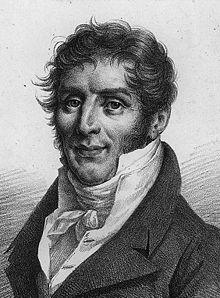André Brochant de Villiers
André Jean Marie Brochant de Villiers (born August 6, 1772 in Mantes-la-Ville , † May 16, 1840 in Paris ) was a French geologist and mineralogist .
Life
Brochant de Villiers was orphaned at an early age and received a good classical education at the Oratorian College in Juilly. In 1791/92 he studied mineralogy at the Freiberg Bergakademie under Abraham Gottlob Werner . He then continued his studies in Paris at the École des Ponts et Chausées, the only special school that still existed during the revolution. When the École polytechnique was founded by Gaspard Monge in 1794 , he was intended for the cadre after he had passed the tough entrance exam very well, but he preferred to switch to the École des Mines, which was also newly founded in 1794 . In 1804 he became professor of geology and mineralogy there. The school had been relocated from Paris to the small mountain village of Pesey in Savoy ( Tarentaise province ) (where one had the advantage of being able to study Alpine geology on site) and he did not return to Paris with the school until 1815. De Villiers also founded the mineral collection of the École des Mines. He passes on the teachings of his teacher Werner to his students. In 1835 he resigned from his professorship, succeeded by his students Léonce Élie de Beaumont (professor of geology) and Armand Dufrénoy (professor of mineralogy). He later acted as inspector general of the mines and director of the mirror factory in Saint-Gobain . He became a member of the Académie des sciences in 1816 . In 1820 he became a Fellow of the Royal Society of Edinburgh .
He owes the Description géologique de la France (Geological Description of France) and the first complete map of France, which he wrote with Léonce Élie de Beaumont and Armand Dufrénoy . He made the first suggestions in 1811. After George Bellas Greenough published his geological map of England in 1819, the desire to create such a map also increased in France. De Villiers, de Beaumont and Dufrenoy traveled to England to familiarize themselves with the stratigraphic methods. The work began in earnest in the mid-1820s (in the summers of 1825 to 1829, the time after which was mainly devoted to drafting) and was carried out mainly by his two students Beaumont and Dufrénoy with assistants. De Villiers was in charge of the overall management and advised the project. The first results were presented to the Academie des Sciences by De Villiers in 1835, but the map did not appear until after De Villiers' death in 1842.
Fonts
- Traité élémentaire de minéralogie, suivant les principes du professeur Werner , rédigé d'après plusieurs ouvrages allemands (German: Basic treatise on mineralogy, based on the principles of Professor Werner, based on several German publications) (2 volumes, 1800–1802)
- Traité abrégé de cristallographie (German: Brief summary of crystallography) (1818)
- Mémoires pour servir à une description géologique de la France, rédigés sous la direction de M. Brochant de Villiers par MM. Dufrénoy et Élie de Beaumont (Eng .: Memories as the basis for a geological description of France, written under the guidance of Monsieur Brochant de Villiers with Monsieur Dufrénoy and Èlie de Beaumont) (4 volumes, 1830–1838)
- Carte géologique de la France exécutée sous la direction de Mr. Brochant de Villiers, Inspecteur général des Mines, par MM. Dufrénoy et Elie de Beaumont, Ingénieur des Mines (German: Geological map of France, prepared under the guidance of Monsieur Brochant de Villiers , General Inspector of the Mines with Monsieur Dufrénoy and Èlie de Beaumont, mining engineer) (1870)
From his pen there are also some mineral descriptions such as those for gray antimonite (synonymous with stibnite ), copper azur (synonymous with azurite ), la prase (synonymous with prasiolite ) and leafy zeolite (synonymous with stilbite ).
Honors
- A street in Paris bears his name ( Rue Brochant , where the artist Barbara was born). It is located in the 17th district, near the metro station.
- The mineral brochantite is named after him.
Web links
Individual evidence
- ^ Fellows Directory. Biographical Index: Former RSE Fellows 1783–2002. Royal Society of Edinburgh, accessed October 12, 2019 .
| personal data | |
|---|---|
| SURNAME | Brochant de Villiers, André |
| ALTERNATIVE NAMES | Brochant de Villiers, André Jean Marie (full name) |
| BRIEF DESCRIPTION | French geologist and mineralogist |
| DATE OF BIRTH | August 6, 1772 |
| PLACE OF BIRTH | Mantes-la-Ville |
| DATE OF DEATH | May 16, 1840 |
| Place of death | Paris |
